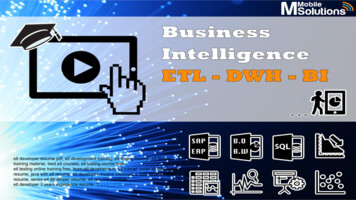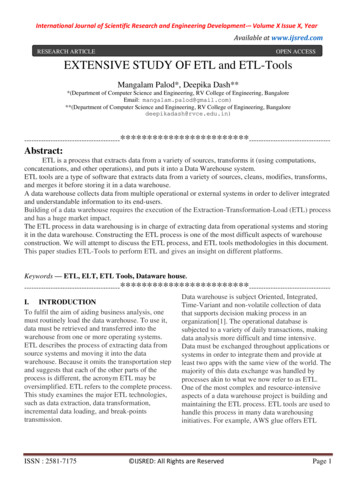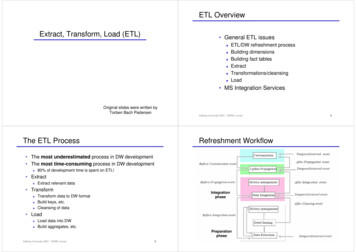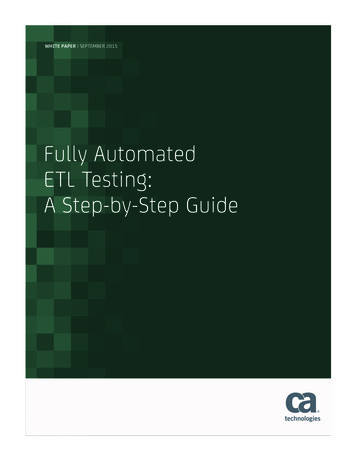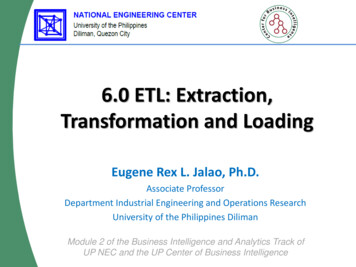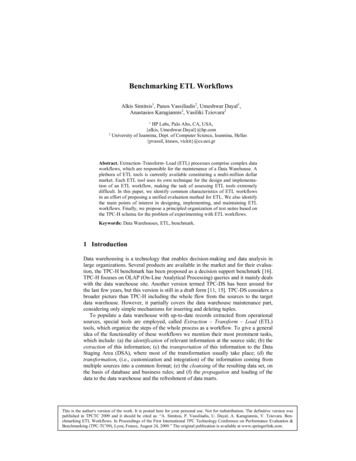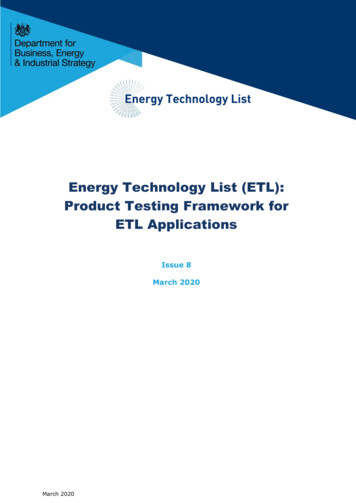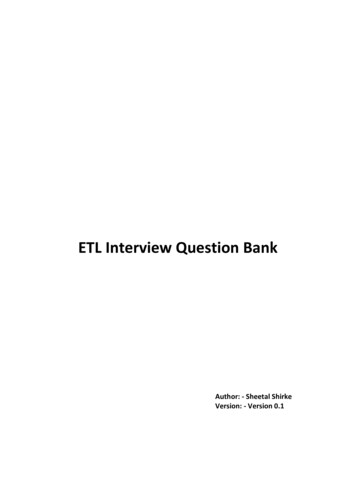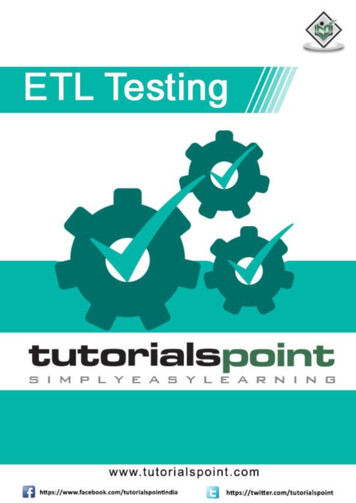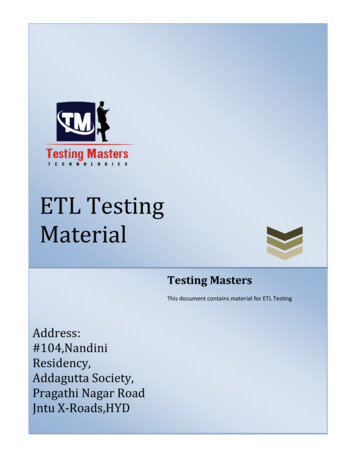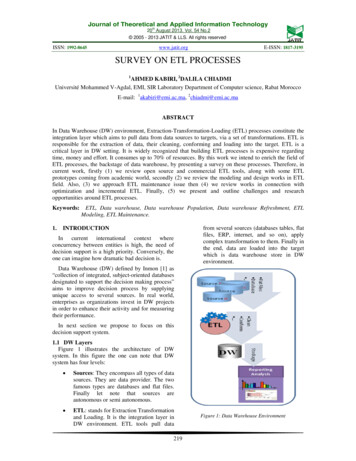
Transcription
Journal of Theoretical and Applied Information Technology20th August 2013. Vol. 54 No.2 2005 - 2013 JATIT & LLS. All rights reserved.ISSN: 1992-8645www.jatit.orgE-ISSN: 1817-3195SURVEY ON ETL PROCESSES1AHMED KABIRI, 2DALILA CHIADMIUniversité Mohammed V-Agdal, EMI, SIR Laboratory Department of Computer science, Rabat MoroccoE-mail: 1akabiri@emi.ac.ma, 2chiadmi@emi.ac.maABSTRACTIn Data Warehouse (DW) environment, Extraction-Transformation-Loading (ETL) processes constitute theintegration layer which aims to pull data from data sources to targets, via a set of transformations. ETL isresponsible for the extraction of data, their cleaning, conforming and loading into the target. ETL is acritical layer in DW setting. It is widely recognized that building ETL processes is expensive regardingtime, money and effort. It consumes up to 70% of resources. By this work we intend to enrich the field ofETL processes, the backstage of data warehouse, by presenting a survey on these processes. Therefore, incurrent work, firstly (1) we review open source and commercial ETL tools, along with some ETLprototypes coming from academic world, secondly (2) we review the modeling and design works in ETLfield. Also, (3) we approach ETL maintenance issue then (4) we review works in connection withoptimization and incremental ETL. Finally, (5) we present and outline challenges and researchopportunities around ETL processes.Keywords:1.ETL, Data warehouse, Data warehouse Population, Data warehouse Refreshment, ETLModeling, ETL Maintenance.INTRODUCTIONIn current international context whereconcurrency between entities is high, the need ofdecision support is a high priority. Conversely, theone can imagine how dramatic bad decision is.from several sources (databases tables, flatfiles, ERP, internet, and so on), applycomplex transformation to them. Finally inthe end, data are loaded into the targetwhich is data warehouse store in DWenvironment.Data Warehouse (DW) defined by Inmon [1] as“collection of integrated, subject-oriented databasesdesignated to support the decision making process”aims to improve decision process by supplyingunique access to several sources. In real world,enterprises as organizations invest in DW projectsin order to enhance their activity and for measuringtheir performance.In next section we propose to focus on thisdecision support system.1.1 DW LayersFigure 1 illustrates the architecture of DWsystem. In this figure the one can note that DWsystem has four levels: Sources: They encompass all types of datasources. They are data provider. The twofamous types are databases and flat files.Finally let note that sources areautonomous or semi autonomous. ETL: stands for Extraction Transformationand Loading. It is the integration layer inDW environment. ETL tools pull data219Figure 1: Data Warehouse Environment
Journal of Theoretical and Applied Information Technology20th August 2013. Vol. 54 No.2 2005 - 2013 JATIT & LLS. All rights reserved.ISSN: 1992-8645www.jatit.orgE-ISSN: 1817-3195 DW: is a central repository to save dataproduced by ETL layer. DW is a databaseincluding fact tables besides dimensiontables. Together these tables are combinedin a specific schema which may be starschema or snowflake schema.are to access available targets and to write theoutcome data (transformed and integrated data) intothe targets. This step can be a very time-consumingtask due to indexing and partitioning techniquesused in data warehouses [6]. Finally, according tofigure 2, this step is performed over target. Reporting and Analysis layer has themission to catch end-user request andtranslate it to DW. Collected data areserved to end-users in several formats. Forexample data is formatted into reports,histograms, dashboard.etcTransformation step is the most laborious onewhere ETL adds value [3]. Indeed during this step,ETL carries out the logic of business processinstanced as business rules (sometime calledmapping rules) and deals with all types of conflicts(syntax, semantic conflicts etc). This step isassociated with two words: clean and conform. Inone hand, cleaning data aims to fix erroneous dataand to deliver clean data for end users (decisionsmakers). Dealing with missing data, rejecting baddata are examples of data cleaning operations. Inother hand, conforming data aims to make datacorrect, in compatibility with other master data.Checking business rules, checking keys and lookupof referential data are example of conformingoperations. At technical level and in order toperform this step, ETL should supplies a set of datatransformations or operators like filter, sort, innerjoin, outer joins etc. Finally this step involvesflow schema management because the structure ofprocessed data is changing and modified step bystep, either by adding or removing attributes.ETL is a critical component in DW environment.Indeed, it is widely recognized that building ETLprocesses, during DW project, are expensiveregarding time and money. ETL consume up to70% of resources [3], [5], [4], [2]. Interestingly [2]reports and analyses a set of studies proving thisfact. In other side, it is well known too, that theaccuracy and the correctness of data, which areparts of ETL responsibility, are key factors of thesuccess or failure of DW projects.Given the fact expressed above, about ETLimportance, the next section presents ETL missionsand its responsibility.1.2 ETL MissionAs its name indicates, ETL performs threeoperations (called also steps) which are Extraction,Transformation and Loading. Upper part of figure 2shows an example of ETL processes with TalendOpen source tool. The second part of figure 2shows the palette of Talend tool that is a set ofcomponents to build ETL processes. In whatfollows, we present each ETL step separately.We refer interested readers to [3] and [5] formore details and explanation of each step.Extraction step has the problem of acquiring datafrom a set of sources which may be local or distant.Logically, data sources come from operationalapplications, but there is an option to use externaldata sources for enrichment. External data sourcemeans data coming from external entities. Thusduring extraction step, ETL tries to access availablesources, pull out the relevant data, and reformatsuch data in a specified format. Finally, this stepcomes with the cost of sources instability besidestheir diversity. Finally, according to figure 2, thisstep is performed over source.Loading step conversely to previous step, has theproblem of storing data to a set of targets. Duringthis step, ETL loads data into targets which are facttables and dimension in DW context. However,intermediate results will be written to temporarydata stores. The main challenges of a loading step220Figure 2: ETL Example and Environment with TalendOpen source
Journal of Theoretical and Applied Information Technology20th August 2013. Vol. 54 No.2 2005 - 2013 JATIT & LLS. All rights reserved.ISSN: 1992-8645www.jatit.orgThe remaining of this paper is organized asfollows. In section 2, we review some open sourceand some commercial ETL tools, along with someETL prototypes coming from academic world.Section 3 deals with research works in the field ofETL modeling and design while section whilesection 4 approaches ETL maintenance issue.Finally, in section 4, we present and outlinechallenges and research opportunities around ETLprocesses. We conclude and present our futureworks in section 6.2. ETLTOOLSPROTOTYPESANDRESEARCHIn Section 1, we present the technique ofmaterial views originally created to refresh the DW.In Section 2, we review ETL tools with examplesof commercial tools as open source tools.2.1 Commercial ETL ToolsA variety of commercial tools overwhelms theETL market which is a promising market. A study[7] conducted by TDWI, identifies a list ofindicators and criteria for their comparison andevaluation. Each commercial ETL tool adopts itsown notation and its won formalism. Consequently,metadata between these tools are not exchangeable.In contrast, among their commonalities, they alloffer a graphical language for the implementationof ETL processes.We distinguish two subfamilies in thecommercial ETL field. On the one hand, there issubfamily of payable ETL DataStage [8] andInformatica [9]. On the other hand, the secondsubfamily of commercial ETL comes with nocharge. In fact, they are free under certainconditions. Indeed, despite the ETL licenses areexpensive, major DBMS (Database ManagementSystem) editors like Oracle and Microsoft, offerthere ETL solution freely for each DBMS licensepurchased. In other words, ETL solution is includedin DBMS package license. In the following wepresent an example of each subfamily.DataStage [8] is the ETL solution of IBM editor.Its basic element for data manipulation is called"stage." Thus, for this tool an ETL process is acombination of "stages." Thus we speak abouttransformation stages and stages for extracting andloading data (called connectors since release 8)which are interconnected via links. The IBMsolution DataStage provides two other tools:Manager and Administrator. They are designed,respectively, for supervising the execution of ETLprocesses and for dealing with ETL projectconfiguration. It should also be noted that IBME-ISSN: 1817-3195offers two versions in its ETL solution: DataSatgeSERVER version and DataSatge PX version. Thislast version has the advantage to manage thepartitioning in data processing. Finally, DataStagegenerates OSH code from ETL job built with stagesplacement.SSIS stands for Sql Server Integration Services.This is the ETL solution of Microsoft editor [10].As mentioned above, SSIS is free with any DBMSSQL SERVER license which includes two extratools that are SSRS and SSAS (respectively forreporting and OLAP analysis). The atomic elementor the basic element in SSIS is called a "task".Thus, for this tool an ETL process is a combinationof tasks. More precisely, SSIS imposes two levelsof tasks combination. The first level is called "FlowControl" and the second level controlled by thefirst, is called "Data flow." Indeed, the first level isdedicated to prepare the execution environment(deletion, control, moving files, etc .) and suppliestasks for this purpose. The second level (data flow)which is a particular task of the first level performsclassical ETL mission. Thus, the Data-Flow taskoffers various tasks for data extraction,transformation and loading.In conclusion of this section, we have presentedcommercial ETL, along with some examples oftheme. In next section, we present another categoryof ETL, open sources tools.2.2 Open Source ETLSome open source tools are leaders in theirarea of interest; for example, Linux in operatingsystem area and Apache server in web servers’area. But the trend is not the same for open sourcebusiness intelligence (BI) tools. They are less usedin the industrial world [11].To understand this restriction of use ofopen source BI tools, Thomsen and Pedersen studythis fact in [11] work. In this perspective, theauthors start by counting BI tools available in opensource with illustration of features of each tool.Then the criteria adopted in this study were defined.Thus, in ETL scope the criteria taken into accountare:221 ROLAP or MOLAP aspect of the tool thatis whether the tool can load relationaldatabases or multidimensional cubes.Incremental mode of the tool that is thefeatures of loading modified data or newlycreated ones.The manner of using the tool; viagraphical interface, via xml fileconfiguration etc.
Journal of Theoretical and Applied Information Technology20th August 2013. Vol. 54 No.2 2005 - 2013 JATIT & LLS. All rights reserved.ISSN: 1992-8645 www.jatit.orgThe richness of offered features.The parallelism or the partitioning usefulfor the treatment of massive data.In summary, ten open source ETLs arepresented and this study concludes that the mostnotables are Talend and Kettle because of theirlarge users’ community, their literature, theirfeatures and their inclusion in BI suites. Finally, letnote that another version of this study is availablein [12].In the following we suggest to look closelyat one of these tools. More precisely, we will limitto Talend tool.Talend is an open source, offering a widerange of middleware solutions that meet the needsof data management and application integration[13]. Among these solutions there are two solutionsfor data integration: Talend Open Studio for DataIntegrationand Talend Enterprise DataIntegration. Respectively, they are a freedevelopment open source tool and non freedevelopment tool that comes with advanceddeployment and management features. Talend dataintegration solution is based on the main followingmodules:1.2.3.Modeler, a tool for creating diagrams. Tothis end, it offers a range of componentsindependent of any technology.Metadata Manager that is a repository forstoring and managing metadata.Job Designer, graphical developmentenvironment for ETL jobs creation. Thistool in turn provides a rich palette ofcomponentsfordataextraction,transformation and loading.From the point of view of a developer, theimplementation of a ETL process with Talend OpenStudio Data Integration consists on the insertion ofcomponents from the palette offered by JobDesigner (more than 400 components). From thepoint of view of a designer, the use of Talendconsists on modeling with Modeler module. Butthe relationship between these two levels is notavailable. In other words, transition from ETLdiagrams built with Modeler to ETL job writtenwith Job Designer is not offered.In next section, we see another type ofETL tools, those coming from research world.E-ISSN: 1817-31952.3 Framework and Tools from ResearchIn this section, we will see some projects,from academic world, dealing with the problem ofETL. These projects are: SIRIUS, ARKTOS,DWPP and PYGRAMETL.SIRIUS (Supporting the IncrementalRefreshment of Information Warehouses) is aproject developed at information technologydepartment in Zurich University. SIRIUS, [14]looks at the refreshment of data warehouses. Itdevelops an approach metadata oriented that allowsthe modeling and execution of ETL processes. It isbased on SIRIUS Meta model component thatrepresents metadata describing the necessaryoperators or features for implementing ETLprocesses. In other words, SIRIUS providesfunctions to describe the sources, targetsdescription and the mapping between these twoparts. At the end, this description leads to thegeneration of global schema. At execution level,SIRIUS generates Java code ready for executionafter a successful compilation. Finally, SIRIUSincludes techniques for detecting changes in theoperational sources (databases exactly) besidessupervision support, for the execution of definedETL processes.ARKTOS is another framework thatfocuses on the modeling and execution of ETLprocesses. Indeed, ARKTOS provides primitives tocapture ETL tasks frequently used [15]. Moreexactly, to describe a certain ETL process, thisframework offers three ways that are GUI and twolanguages XADL (XML variant) and SADL (SQLlike language). An extension of this work isavailable in [16] where authors discuss the metamodel of their prototype. The basic element inARKTOS is called an activity whose logic isdescribed by a SQL query. At execution level,ARKTOS manages the execution of each activityand associate it with the action to take when anerror occurs. Six types of errors are taken intoaccount. Firstly, they are 1) violation of theprimary key, 2) violation of the uniqueness and 3)violation of reference. These three types are specialcases of integrity constraints violation. The othertype of error is 4) NULL EXISTENCE for theelimination of missing values. Finally, the tworemaining errors types are 5) FIELD MISMATCHand 6) FORMAT MISMATCH related respectivelyto domain errors and data format errors.PYGRAMETL(Pythonbasedframework) is a programming framework for ETL222
Journal of Theoretical and Applied Information Technology20th August 2013. Vol. 54 No.2 2005 - 2013 JATIT & LLS. All rights reserved.ISSN: 1992-8645www.jatit.orgprocesses [17]. In this work, the authors attempt toprove that ETL development based on a graphicaltool are less efficient than conventional ETLdevelopments (code editing). In other words,instead of using a graphical palette of components,and then proceed by inserting and personalize theelements of this palette, it is more appropriate tomake codes and create scripts via a programminglanguage. In this perspective, PYGRAMETLsuggests coding with Python language. Also itoffers a set of functions most commonly used in thecontext of populating data warehouses such asfiltering data and feeding slowly changingdimensions. Finally, the authors of PYGRAMETLpresent, as illustration, a comparison betweenPYGRAMETL (their tool) and PENTAHOO, anopen source ETL tool.Another interesting work that touches theETL is available in [18]. This work which focuseson ETL performance that is a fundamental aspectamong others of ETL, presents DWPP (DataWarehouse Population Platform). DWPP is a set ofmodules designed to solve the typical problems thatoccur in any ETL project. DWPP is not a tool but itis a platform. Exactly, it is C functions libraryshared under UNIX operating system for theimplementation of ETL processes. Consequently,DWPP provides a set of useful features for datamanipulation. These features are structured in twolevels. Indeed, the first level is based on thefeatures of operating system and those of the OracleDBMS (the chosen target for DWPP) while thesecond level regroups developed features which arespecific and useful in ETL treatment. Finally, asthis work comes from a feedback on thedevelopment and deployment of DWPP basedlarge-scale ETL projects, it does not address thevariety of sources nor targets. Indeed, DWPP islimited to flat files as source and Oracle DBMS astarget. Another work associated to DWPP isavailable in [6] where authors give more details onthe functional and technical architecture of theirsolutions. In addition, the authors discuss some ofthe factors impacting the performance of ETLprocesses. Thus, the authors address the physicalimplementation of the database with focus on datapartitioning as well as pipelining and parallelism.These aspects are addresses using UNIX operatingsystem functionalities.During this section we have presentedopen source ETL tools as commercial tools, alongwith some prototype from academic world. In nextE-ISSN: 1817-3195section, we deal with ETL design and modeling.We present related works to these issues.3.ETL MODELING AND DESIGNResearch in data warehouse field isdominated by the DW design and DW modeling.ETL field is not an exception to this rule. Indeed, inthe literature one can note several research effortsthat treat DW population performed by ETLprocesses. (ETL) are areas with high added valuelabeled costly and risky. In addition, softwareengineering requires that any project is doomed toswitch to maintenance mode. For these reasons, it isessential to overcome the ETL modeling phase withelegance in order to produce simple models andunderstandable. Finally, as noted by Booch et al in[19], we model a system in order to: Express its structure and behavior.Understand the system.View and control the system.Manage the risk.In the following we go through researchworks associated with ETL design.3.1 Meta-models based Works on ETL DesignDuring DOLAP 2OO2 conference,Vassiliadis et al [20] present an attempt toconceptual modeling of ETL processes. The authorsbased their argument on the following two points.At the beginning of a BI project, the designer needsto:1.2.Analyze the structure and the content ofsources.Define mapping rules between sources andtargets.The proposed model, based on metamodel, provides a graphical notation to meet thisneed. Also, a range of activities commonly used bythe designer is introduced.The model in question continues bydefining two concepts: the Concept andRelationship-Provider. Respectively, it is a sourceor a target with their attributes and relationshipsbetween attributes (fields of source or target).Transformations are dissociated with mapping rules(Relationship-Provider). Indeed, in order totransform attributes such as removing spaces orconcatenating attributes, Provider Relationship uses223
Journal of Theoretical and Applied Information Technology20th August 2013. Vol. 54 No.2 2005 - 2013 JATIT & LLS. All rights reserved.ISSN: 1992-8645www.jatit.organ extra node (element of the model). Ignoringwhich source to prioritize to extract data, the modelintroduces candidate relationship to designate allsources likely to participate in DW population. Theselected source is denoted active relationship.The authors complement their model viaan extensive paper [21] by proposing a method forthe design of ETL processes. Indeed, in this work,the authors expose a method to establish a mappingbetween the sources and targets of ETL process.This method is spread over four steps:1.2.3.4.Identification of sourcesDistinction between candidates’ sourcesand active sources.Attributes mapping.Annotation of diagram (conceptual model)with execution constraints.Works around this model are reinforced by anattempt to transition from conceptual model tological model. This is the subject of [22] paperwhere authors define a list of steps to follow toinsure this transition. In addition, this workproposes an algorithm that groups transformationsand controls (at conceptual level) into stages thatare logical activities. Finally, a semi-automaticmethod determining the order execution of logicalactivities is defined too.Another work around ETL presentsKANTARA, a framework for modeling andmanaging ETL processes [4]. This work exposesdifferent participants that an ETL project involvesparticularly designer and developer. After theanalysis of interaction between main participants,authors conclude that designer needs helpful tool,which will makes easy the design and maintenanceof ETL processes. In response, authors introducenew graphical notation based on a meta-model. Itconsists mainly on three core components whichare, Extract, Transform and Load components.These components are chosen according to ETLsteps. Besides, each component manages a set ofspecific meta-data close to its associate step. Thiswork is consolidated with another work presentinga method for modeling and organizing ETLprocesses [23]. Authors start by showing functionalmodules that should be distinguished in each ETLprocess. This leads to distinguish several modules,especially Reject Management module for which aset of metadata to manage are defined. Theproposed approach takes five inputs (namelymapping rules, conforming rules, cleaning rules,and specific rules) and produces a conceptualE-ISSN: 1817-3195model of an ETL processes using a graphicalnotation presented previously.3.2 UML Based WorksIn 2003 Trujillo [24] proposes a newapproach, UML based for the design of ETLprocesses. Finding that the model of Vassiliadis[20] is based on ad-hoc method, the authors attemptto simplify their model and to base it on a standardtool. In this model, an ETL process is considered asclass diagram. More precisely, a basic ETL activitywhich can be seen as a component is associatedwith a UML class and the interconnection betweenclasses is defined by UML dependencies. Finally,the authors have decided to restrict their model toten types of popular ETL activities such asAggregation, Conversion, Filter and Join, which inturn are associated to graphical icons.In 2009 (DOLAP 2009), Munoz et almodernize this model through a new publication[25] dealing with the automatic generation of codefor ETL processes from their conceptual models. Infact, the authors have presented a solution orientedMDA. It is structured as follows: For PIM (Platform Independent Model)layer, which corresponds to conceptuallevel, ETL models are designed usingUML formalism, more precisely the resultof the previous effort.For PSM (Platform Specific Model) layerwhich corresponds to the logical level, theplatform chosen is Oracle platform.For the Transformation layer that allowsthe transition from PIM model to PSMmodel is made with QVT (Query ViewTransformation)language.Thesetransformations can bind PIM meta-modelelements to PSM meta-model elements.Another research team presents in [26]another research effort about ETL and UML based.But this work is restricted to extraction phaseomitting transformations and loading phases. Thus,this work presents an approach object-oriented formodeling extraction phase of an ETL process usingUML 2. To this end, authors present and illustratethe mechanism of this phase as three diagrams.These diagrams are class diagram, sequencediagram and use case diagram of extraction phase.Finally, six classes which are data staging area,data sources, wrappers, monitors, integrator andsource identifier are shown. These classes are usedand in above diagrams.224
Journal of Theoretical and Applied Information Technology20th August 2013. Vol. 54 No.2 2005 - 2013 JATIT & LLS. All rights reserved.ISSN: 1992-8645www.jatit.org3.3 Web Technologies Based WorksThe advent of the web has disruptedinformation systems. ETL in turn are affected bythis wave. Indeed, semantic web technologies areused in the development of data warehousesrefreshment processes. Thus, in 2006 Skoutas et alpresent an ontology based approach for the designof ETL processes [27]. Applied to a given domainwhose concepts are identified, OWL (web ontologylanguage) is used to construct the domain ontologyin question. Then the OWL ontology constructed isexploited to annotate and mark schemas of bothsources and DW (target). Finally, a reasoningtechnique is put into action to induce connectionsand conflicts between the two extremes (betweensource and DW). This approach is semi-automaticand allows getting a part of necessary elements forthe design of ETL. Namely, they are mapping rulesand transformations between sources and targetattributes. However, this work suffers from twofollowing drawbacks:1.2.The scope of the data is limited torelational sources.Ontology construction is not efficient.Therefore, the same authors enhance theirproposal in 2007 via an extension of their work[28]. The scope of data handled is expanded toinclude structured data and unstructured data.Finally, a prototype of the solution is implementedin Java.It is clear that the contribution of thisapproach is relevant, but it is still insufficient.Indeed, a conceptual model is not limited to themapping rules, but there is also (among other) theData Flow to manage which consists on activitiesorchestration and arrangement. Finally, let note thatresults accuracy of applying this approach is closelyrelated to the degree of matching between ontologyand schemas of sources and DW. Furthermore, inreality, the schemas of sources are not expressive ornon-existent [3].Another approach based on webtechnologies, more precisely on marriage betweenBPMN (Business Process Modeling Notation) andBPEL (Business Process Execution Language) ispresented in [29]. This work aims to align to MDAstandard. Indeed, it proposes to use BPMN for thePIM layer and to use BPEL for PSM layer.Nevertheless transformation layer is not welldeveloped in spite of the transition from BPMN toE-ISSN: 1817-3195BPEL is mentioned. In fact, this work considersthat the mapping between BPMN and BPEL isacquired and provided by multiple tools. Finally,this effort provides an extensible palette of usefulfeatures for the ETL design using BPMN notation.Another interesting work related to the design ofETL based on RDF (Resource DescriptionFramework) and OWL, two web technologies, isdetailed in [30]. This work has the advantage ofpresenting a method over several steps rangingfrom the creation of models for ROLAP cubes untilthe creation of the ETL layer. The basic idea behindthis work is to convert the data source to a RDF fileformat that is consistent with OLAP ontologywhich is constructed in turn. Then target tables arepopulated with data extracted via queries generatedover OLAP ontology.The scientific community has enriched the field ofmodeling ETL with different approaches presentedabove. These proposals differ in the formalism andthe technology used. But they have the samedrawback that is the lack of support andapproaches to change management in ETL. In nextsection, we cover this issue.4.MAINTENANCE OF ETL PROCESSESETL process can be subject of changes forseveral reasons. For instance, data sources changes,new requirements, fixing bugs etc. When changeshappen, analyzing the impact of change ismandatory to avoid errors and mitigate the risk ofbreaking existent treatments.Generally, change is neglected although it is afundamental aspect of information systems anddatabase [31]. Often, the focus is on building andrunning systems. Less attention is paid to the wayof making easy the management of change insystems [32]. As a consequence, without a helpfultool and an effective approach for changemanagement, the cost of maintenance task will behigh. Particularly for ETL processes, previouslyjudged expensive and costly.Research community catches this need andsupplies, in response, few solutions. The one canstarts with a general entry point to change issue in[31] that is a report on evolutions and data changesmanagement. Indeed, authors summarize theproblems associated with this issue as well as acategorization of these problems. Finally, theauthors discuss the change issue according to six225
Journal of Theoretical and Applied Information Technology20th August 2013. Vol. 54 No.2 2005 - 2013 JATIT & LLS. All rights reserved.ISSN: 1992-8645www.jatit.orgaspects which are: What, Why, Where, When, Whoand How.Regarding data warehouse layer, change canoccur at two levels, either in schemas or in datastored from the first load of data warehouse.Managing data evolution, contrarily to schemaevolution, over time is a
In Section 2, we review ETL tools with examples of commercial tools as open source tools. 2.1 Commercial ETL Tools A variety of commercial tools overwhelms the ETL market which is a promising market. A study [7] conducted by TDWI, identifies a list of indicators and criteria for their comparison and evaluation. Each ETLcommercial tool adopts its
